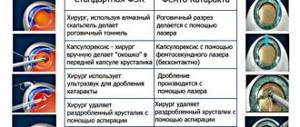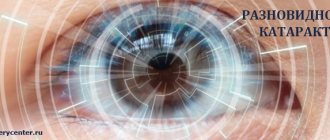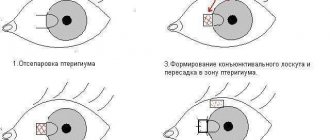08/14/2015 In essence, cataracts are a disease that occurs due to clouding of the lens. In some cases, cataracts occur against the background of glaucoma, and both diseases represent a combined pathology in one patient, that is, clouding of the lens is combined with high pressure inside the eye.
Causes of senile cataracts
The main cause of senile cataracts is biochemical changes that occur as a result of aging of the body. This is a natural process, and no one can be immune from its development. The lens contains protein compounds that maintain its transparency. With age-related changes, denaturation of these substances occurs, the structure of protein molecules and their natural properties are disrupted. Imagine an egg white that loses its transparency when cooked, and it is no longer possible to get it back. About the same thing happens in the lens of the eye. This phenomenon occurs gradually, and the clouding process can take from 4 to 15 years. At the primary stage, changes can affect only the peripheral zone of the lens, without entering the optical region and without affecting vision. A person does not even suspect that he is developing cataracts. Over time, the cloudiness also spreads to the central part, already interfering with the passage of light, and vision begins to noticeably deteriorate. At strong degrees it decreases only to light perception, and objects become indistinguishable. There are also external changes in the color of the pupil: from black it becomes grayish, then gradually whitish. In this case, even without diagnosis it is clear that it is a cataract.
The only effective way to regain clarity of vision is surgery, replacing the lens of the eye with an artificial one (IOL - intraocular lens), whose properties are as close as possible to the real one.
What determines the outcome of surgery in old age?
Cataracts in elderly patients have a very destructive effect on vision. Phacoemulsification, performed by a professional, can restore all or part of its sharpness. Unfortunately, not only the qualifications of a doctor and the availability of modern equipment are the key to success. The initial state of eye health plays a major role.
A clouded lens interferes with assessing the condition of the fundus. The doctor cannot always determine whether there are pathologies of the optic nerve or retina. To do this, additional research is carried out to help see the overall picture. But even in this case, there is no 100% guarantee of a correct diagnosis. It is better to perform the operation in the initial stages of the development of the pathology; the chances of complete restoration of vision are very high.
Ultrasound treatment of cataracts
Ultrasound phacoemulsification of cataracts with IOL implantation is the name of one of the operations for cataract removal. Doctors themselves recognize this method as safe. All over the world, millions of similar procedures are performed annually, giving people a chance to regain high-quality vision. The idea of destroying the lens using ultrasound was first proposed by Charles Kelman, an American ophthalmic surgeon, in 1967. But then the imperfection of existing technologies prevented its implementation. In Russia, the first such operations began to be carried out in the mid-90s, when the appropriate equipment became available.
What not to do after cataract surgery
It is not recommended to drive for one month after cataract removal. After all, vision will be very sensitive, and any sudden ray of sun or glare from a chrome surface can blind. Of course, this may lead to a traffic accident.
You need to sleep in certain positions. It is forbidden to sleep on your stomach. After all, you can accidentally injure your eye. You should also not sleep on your side on the side where the surgery was performed. In this case, it is recommended to sleep on your back. But it’s best not to use a large and fluffy pillow, but just do without it for the first time.
It is also necessary to limit yourself from lifting heavy objects. In the first month, the maximum weight that you can lift should not exceed three kilograms.
You can make an appointment and ask clarifying questions to our specialists by phone in Moscow (daily from 9:00 to 21:00), using the feedback form on the website.
Dagaev Adam Huseinovich
When is surgery scheduled?
It is usually carried out at the second or third stage of the disease if the following symptoms are present:
- decreased vision up to 50%;
- the appearance before the eyes of various optical effects (spots, dots) that prevent the patient from leading a normal lifestyle;
- When looking at a light source, halos and glare appear before the eyes.
These signs indicate that lens replacement is necessary, otherwise the consequences may be irreversible.
Indications
- Reduced visual acuity by more than 50%.
- The appearance of various optical effects (fog, veil, glare) that interfere with the performance of professional duties and cause significant discomfort to the patient.
- Cataract at any stage of development.
- Increased sensitivity of the eyes to bright light.
If you ignore the appearance of signs indicating pathology of the visual analyzer and do not perform surgery on time, progressive cataracts will ultimately lead to complete loss of vision.
Contraindications
Despite the gentle nature of the cataract phacoemulsification procedure, a number of conditions have been identified in which surgical intervention can cause deterioration in the patient’s health or lead to postoperative complications.
- Acute infectious or exacerbation of chronic diseases.
- Diabetes mellitus in the stage of decompensation.
- Associated pathologies of the organ of vision: infectious-inflammatory, oncological processes of various eye structures, decompensated glaucoma, secondary cataracts, complete blindness.
- Periods of pregnancy and breastfeeding.
- Severe somatic and mental disorders.
Some of the restrictions relate to temporary contraindications and after stabilization of the condition, the operation becomes possible.
Stages of lens replacement using ultrasound
The operation consists of several stages and is performed under local anesthesia:
- An incision no larger than 1.8 mm is made on the eye with a sharp diamond knife. The tip of a phacoemulsifier is inserted into it, and under the influence of low-frequency ultrasound, the nucleus of the lens is destroyed. Then fractional pieces are removed from the eye using aspiration (suction).
- Next comes the stage of replacing the damaged lens and implanting an artificial lens. It is rolled into a tube and inserted into the same incision through a special injector. Inside, it straightens out, takes the desired position and is held in the eye by supporting elements - “antennae”. Such lenses are also called “lenses with memory.”
- The incision does not need to be sutured; it seals itself.
Benefits of Ultrasonic Phacoemulsification
The operation is performed on an outpatient basis and takes little time. Within a few hours the patient can go home. The rehabilitation period takes a month, during which you need to follow a certain diet and limit certain activities (for example, driving a car). After just two months, the patient can return to their normal rhythm of life. Vision is restored almost immediately after surgery, and modern multifocal lenses provide the highest quality of vision. The IOL is selected individually for each patient.
Replacing the lens of the eye with a laser
The second way to restore vision with cataracts is phacoemulsification using a femtosecond laser. Laser lens correction is prescribed in more complex cases, for example, cataracts complicated by glaucoma, dislocation or subluxation of the lens, hardened lens that is no longer sensitive to ultrasound.
The equipment for such a procedure is more expensive, so its cost will be higher than with intervention with ultrasound. But with the help of a laser beam, the most complex types of cataracts can be cured. The stages of the operation are identical to ultrasonic phacoemulsification, with the only difference being that crushing occurs using a laser beam. What are the advantages of laser intervention?
Expert opinion
Pershin Kirill Borisovich
Medical Director of Excimer Clinics
Cataracts, as a rule, develop gradually; a person suffering from this disease may not immediately feel deterioration in vision and recognize the disease. But with cataracts, the natural lens often not only becomes cloudy, but also increases in size, which can result in an increase in intraocular pressure, which has a detrimental effect on the optic nerve. And here lies a serious danger: vision in such a situation is lost irreversibly, while the formidable changes occurring in the eye may well go unnoticed for the time being. Only timely diagnosis and competent, professional treatment will help to avoid such a situation!
Benefits of laser cataract treatment
The impact of the laser is more precise. It removes the smallest particles of the destroyed lens, so, for example, the risk of secondary cataracts is practically reduced to zero. In general, the percentage of complications after replacing the eye lens with a laser is very small. The femtosecond laser acts on cells in a targeted manner, therefore protecting the posterior layer of the epithelium from damage. The recovery period takes a short time, and soon the patient can return to normal life.
Prices for operations
The final cost of the operation is determined by the doctor after a complete diagnosis. The price is significantly influenced by the type of intraocular lens - depending on the characteristics, it can vary from several thousand rubles to 90-100 thousand. The qualifications of the surgeon who performs the surgery, the level of the clinic, the cost of equipment and many other factors also matter. If we talk about ultrasound surgery, its cost starts from about 30 thousand rubles per eye, the upper limit reaches almost 100 thousand. Surgical intervention using a laser is more expensive: the lower limit is from 40 thousand rubles and can exceed 100 thousand. For example, phacoemulsification of a cataract with implantation of a multifocal toric IOL in one of the well-known clinics will cost 133 thousand rubles per eye (information from the clinic’s website for May 2021). But implantation of a simpler lens, which will require glasses for near reading, will cost 40 thousand rubles per eye.
Which is better - ultrasound or laser? This question is asked by every person who needs surgery. In this case, the answer depends on many factors: eye condition, degree of cataract, financial capabilities. The final decision is made by the patient after collecting all the information, as well as based on the advice of the ophthalmologist.
Advantages of Professor Trubilin’s clinic
Patients prefer to have surgery with us for several reasons:
- The reputation of a family clinic, where treatment is not “on stream”, but is personally controlled by the chief physician at all stages;
- Personalized approach with a personal interest in a successful, long-term result for each patient;
- Alexander Trubilin is the current curator of the cataract phacoemulsification cycle at the FMBA of the Russian Federation and an instructor in the phacoemulsification development program (Alcon);
- The clinic’s doctors make presentations at Russian and international conferences and take part in ophthalmologist congresses;
- The clinic conducts extensive scientific and practical activities, training practicing ophthalmic surgeons and introducing into its work the best experience of the world's luminaries of ophthalmic surgery.
- Many times we have restored hope to those patients who despaired of regaining full vision - this is not a miracle, but the well-coordinated work of a highly professional team of sensitive doctors, determined only for success!











